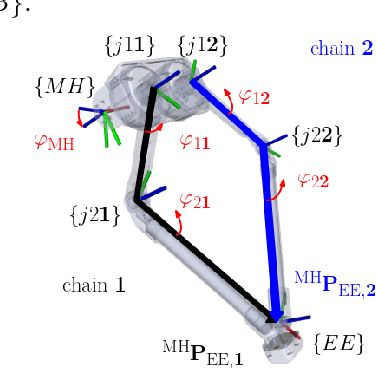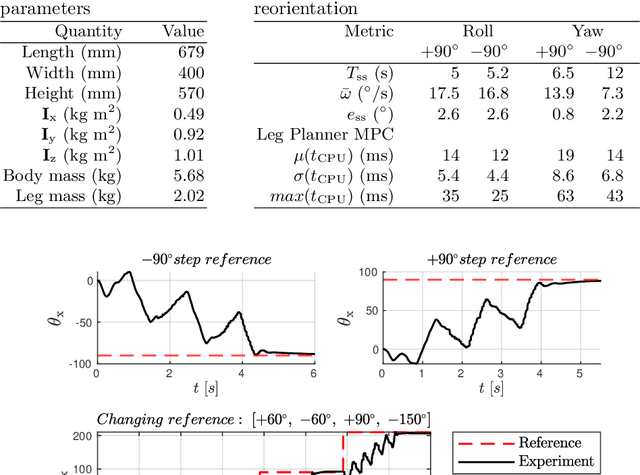Michail Papadakis
Modeling and In-flight Torso Attitude Stabilization of a Jumping Quadruped
Sep 22, 2024



Abstract:This paper addresses the modeling and attitude control of jumping quadrupeds in low-gravity environments. First, a convex decomposition procedure is presented to generate high-accuracy and low-cost collision geometries for quadrupeds performing agile maneuvers. A hierarchical control architecture is then investigated, separating torso orientation tracking from the generation of suitable, collision-free, corresponding leg motions. Nonlinear Model Predictive Controllers (NMPCs) are utilized in both layers of the controller. To compute the necessary leg motions, a torque allocation strategy is employed that leverages the symmetries of the system to avoid self-collisions and simplify the respective NMPC. To plan periodic trajectories online, a Finite State Machine (FSM)-based weight switching strategy is also used. The proposed controller is first evaluated in simulation, where 90 degree rotations in roll, pitch, and yaw are stabilized in 6.3, 2.4, and 5.5 seconds, respectively. The performance of the controller is further experimentally demonstrated by stabilizing constant and changing orientation references. Overall, this work provides a framework for the development of advanced model-based attitude controllers for jumping legged systems.
Identifying Misinformation on YouTube through Transcript Contextual Analysis with Transformer Models
Jul 22, 2023


Abstract:Misinformation on YouTube is a significant concern, necessitating robust detection strategies. In this paper, we introduce a novel methodology for video classification, focusing on the veracity of the content. We convert the conventional video classification task into a text classification task by leveraging the textual content derived from the video transcripts. We employ advanced machine learning techniques like transfer learning to solve the classification challenge. Our approach incorporates two forms of transfer learning: (a) fine-tuning base transformer models such as BERT, RoBERTa, and ELECTRA, and (b) few-shot learning using sentence-transformers MPNet and RoBERTa-large. We apply the trained models to three datasets: (a) YouTube Vaccine-misinformation related videos, (b) YouTube Pseudoscience videos, and (c) Fake-News dataset (a collection of articles). Including the Fake-News dataset extended the evaluation of our approach beyond YouTube videos. Using these datasets, we evaluated the models distinguishing valid information from misinformation. The fine-tuned models yielded Matthews Correlation Coefficient>0.81, accuracy>0.90, and F1 score>0.90 in two of three datasets. Interestingly, the few-shot models outperformed the fine-tuned ones by 20% in both Accuracy and F1 score for the YouTube Pseudoscience dataset, highlighting the potential utility of this approach -- especially in the context of limited training data.
On Evaluating Adversarial Robustness of Chest X-ray Classification: Pitfalls and Best Practices
Dec 15, 2022Abstract:Vulnerability to adversarial attacks is a well-known weakness of Deep Neural Networks. While most of the studies focus on natural images with standardized benchmarks like ImageNet and CIFAR, little research has considered real world applications, in particular in the medical domain. Our research shows that, contrary to previous claims, robustness of chest x-ray classification is much harder to evaluate and leads to very different assessments based on the dataset, the architecture and robustness metric. We argue that previous studies did not take into account the peculiarity of medical diagnosis, like the co-occurrence of diseases, the disagreement of labellers (domain experts), the threat model of the attacks and the risk implications for each successful attack. In this paper, we discuss the methodological foundations, review the pitfalls and best practices, and suggest new methodological considerations for evaluating the robustness of chest xray classification models. Our evaluation on 3 datasets, 7 models, and 18 diseases is the largest evaluation of robustness of chest x-ray classification models.
MUTEN: Boosting Gradient-Based Adversarial Attacks via Mutant-Based Ensembles
Sep 27, 2021



Abstract:Deep Neural Networks (DNNs) are vulnerable to adversarial examples, which causes serious threats to security-critical applications. This motivated much research on providing mechanisms to make models more robust against adversarial attacks. Unfortunately, most of these defenses, such as gradient masking, are easily overcome through different attack means. In this paper, we propose MUTEN, a low-cost method to improve the success rate of well-known attacks against gradient-masking models. Our idea is to apply the attacks on an ensemble model which is built by mutating the original model elements after training. As we found out that mutant diversity is a key factor in improving success rate, we design a greedy algorithm for generating diverse mutants efficiently. Experimental results on MNIST, SVHN, and CIFAR10 show that MUTEN can increase the success rate of four attacks by up to 0.45.
 Add to Chrome
Add to Chrome Add to Firefox
Add to Firefox Add to Edge
Add to Edge